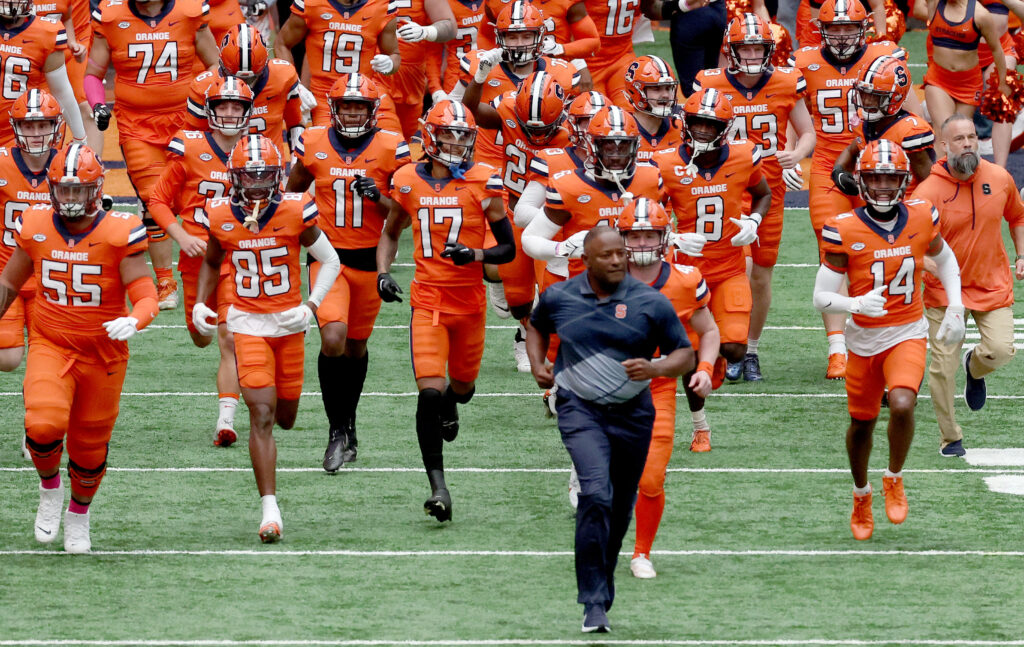Team History
The Syracuse Orange football team, tracing its roots back to 1889, has evolved from humble beginnings to a prominent figure in college football. The program’s early success laid the groundwork for a tradition rich in achievement and innovation. Notably, the construction of Archbold Stadium in 1907 marked a pivotal moment, establishing a home that would see many of the team’s historic moments. The Orange’s reputation grew under the guidance of legendary coaches and through the exceptional play of its athletes, setting the stage for a legacy that would influence the sport on and off the field.
Over the decades, Syracuse has been a crucible of football talent and strategic innovation, contributing significantly to the development of college football. From pioneering the integration of African-American athletes in collegiate sports to challenging the norms of the game, Syracuse’s impact is undeniable. The program has produced a myriad of professional NFL players, Hall of Famers, and has left an indelible mark on the history of college football, demonstrating resilience and excellence through changing times.
Foundation and Early Years
The foundation of Syracuse football is a tale of ambition and modest beginnings, with its first game played in 1889 against the University of Rochester. This early foray into football marked the beginning of a storied journey. The construction of Archbold Stadium in 1907 was a significant milestone, symbolizing the university’s commitment to its football program and setting a precedent for future successes. Under the stewardship of coach Frank “Buck” O’Neill, Syracuse began to emerge as a formidable force in the college football landscape, highlighted by innovative strategies and a growing fanbase.
The early 20th century was a period of growth and success for Syracuse, featuring the emergence of stars like Vic Hanson, who excelled in multiple sports. Hanson’s unique achievements underscored the multi-talented individuals that defined Syracuse’s early years. The program’s commitment to excellence was evident in its rapid ascent to prominence, characterized by significant victories and the development of a competitive spirit that would define Syracuse football for generations to come.
Notable Early Achievements
Syracuse’s early achievements set the stage for its enduring legacy in college football. The invitation to the 1915 Rose Bowl, although declined, signified the program’s rising status on the national stage. The 1920s and 1930s further cemented Syracuse’s reputation, with standout athletes like Vic Hanson and Wilmeth Sidat-Singh breaking barriers and setting records. Hanson’s dual induction into both the College Football and Basketball Halls of Fame, and Sidat-Singh’s groundbreaking role as a quarterback in an era of segregation, highlight the program’s impact beyond just wins and losses.
The courage and talent of Syracuse’s early players not only led to on-field success but also challenged societal norms, with the program being among the first to integrate African-American athletes in significant roles. These pioneering efforts reflected the university’s commitment to equality and progress, setting a precedent for inclusivity in sports. The achievements of this era laid a foundation of excellence and resilience, qualities that continue to define Syracuse Orange football.
Periods of Change
Syracuse football has undergone several periods of significant change, adapting to the evolving landscape of college football. The transition from Archbold Stadium to the Carrier Dome in 1980 marked a new era, offering state-of-the-art facilities and reaffirming Syracuse’s commitment to its athletic programs. These periods of change were often accompanied by shifts in coaching philosophies and playing styles, as the program sought to maintain its competitive edge and relevance in the national conversation.
The tenure of coaches like Ben Schwartzwalder in the mid-20th century brought stability and success, including a national championship in 1959. Schwartzwalder’s leadership exemplified the program’s ability to adapt and thrive, fostering a culture of excellence that propelled Syracuse to national prominence. These changes, both in infrastructure and leadership, underscored the program’s resilience and its relentless pursuit of success.
Championships and Achievements
Syracuse’s football program boasts a rich history of championships and individual achievements, highlighted by its 1959 national championship win. This victory, under coach Ben Schwartzwalder, remains a pinnacle of Syracuse’s athletic achievements, showcasing the team’s dominance in that era. The program’s consistent success in bowl games and the production of All-Americans and professional NFL players further attest to its sustained excellence and impact on the sport.
Beyond team accomplishments, Syracuse has been a breeding ground for individual talent, with legends like Jim Brown, Ernie Davis, and Floyd Little donning the Orange jersey. These players not only achieved greatness on the field but also left a lasting legacy off it, embodying the spirit and values of Syracuse football. The program’s contributions to the sport extend beyond victories, shaping the game and its cultural significance.
Current Roster
The current roster of the Syracuse Orange football team showcases a blend of experience and emerging talent, poised to contribute to the program’s legacy. With players from across the country and around the world,the roster reflects a commitment to building a competitive team. This diversity is not only geographical but also in the range of skills and positions represented, from quarterbacks with precise passing abilities to defensive linemen with formidable tackling prowess.
Each player brings unique strengths to the team, contributing to a collective effort aimed at achieving success in the highly competitive environment of college football. The development of these athletes, under the guidance of the coaching staff, is crucial for the team’s performance each season.
Management and Coaching Staff
At the helm of the Syracuse Orange football program is head coach Fran Brown, whose leadership and recruiting acumen are central to the team’s strategy and future prospects. Brown’s approach to building the team focuses on leveraging his deep ties to the Northeast and his exceptional ability to identify and nurture talent.
His coaching philosophy emphasizes authenticity and the development of strong relationships with players, aiming to foster a supportive and competitive environment. The coaching staff’s collective experience and dedication play a pivotal role in preparing the team for the challenges of collegiate football, ensuring that Syracuse continues to compete at the highest levels.
Home Stadium Information
The Carrier Dome, home to the Syracuse Orange football team, stands as a symbol of the university’s athletic spirit and a centerpiece of its sports infrastructure. Known affectionately as “The Loud House,” its unique domed structure and electric atmosphere make it one of the most distinctive venues in college sports. The Dome not only hosts football games but also serves as a venue for basketball, lacrosse, and other events, embodying the vibrant sports culture at Syracuse. The ongoing commitment to enhancing the stadium experience for fans and athletes alike underscores the importance of the Carrier Dome to the university and the broader community.
The evolution of the Syracuse Orange football program, from its early days to its current status, reflects a journey marked by significant achievements, challenges, and a constant pursuit of excellence. The legacy of the program is not just in its victories or notable athletes but also in its impact on the sport and its contribution to the broader narrative of college football. As the program looks to the future, the dedication of its players, coaches, and support staff ensures that Syracuse Orange football will continue to be a significant force in the years to come.
-
*********** ***** ******* *** ***** ** ************ **** ********* *****dd.mm.yyyy 00:00 PM
-
****** *********** **** ** ***** ****** *** **** *** ******: ********* *** ******* *** ****'* ****dd.mm.yyyy 00:00 PM
-
*********-***** ********: **** 6 **** *** ***** *** * ********* **** 7dd.mm.yyyy 00:00 PM
-
**********-************ *******: ****** ****ć, ******* *******, *** * ********* ********** ********dd.mm.yyyy 00:00 PM
-
********* **** ********* ** *** ***: ********* *** ********* ** ****** ******** **. *** *** *****dd.mm.yyyy 00:00 PM
-
****************** ******* **********: *** ********' **** ****dd.mm.yyyy 00:00 PM







